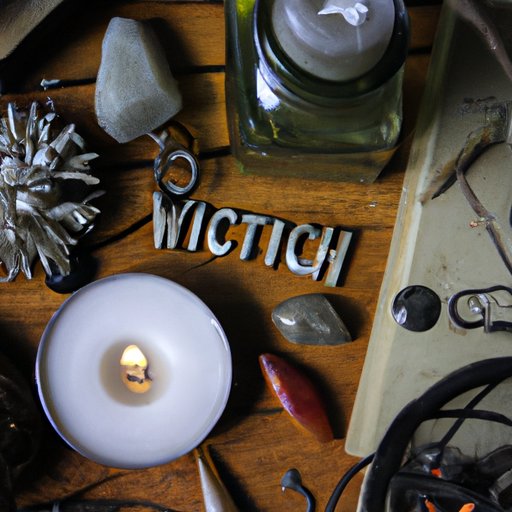
Introduction
Witchcraft is an ancient practice that has piqued our curiosity and fascination for generations. Whether you’re drawn to the idea of a mysterious spiritual connection or want to explore the power of spells, becoming a witch is accessible to anyone who feels called to it. This article will provide you with a beginner’s guide on how to become a witch, examining some basic steps, beliefs, tools, and practices involved.
The Basics of Witchcraft
Witchcraft is an umbrella term that encompasses many different beliefs, practices, and traditions. It’s essential to understand what you’re getting into before diving in. Witchcraft is often associated with pagan traditions, and many witches also practice Wicca, but the two terms are not interchangeable.
Witches are people who work with the forces of nature and magic to create change in the world. This could involve casting spells, creating potions, or performing rituals. There are many different kinds of witches, each with their own beliefs and practices. Solitary witches work alone, while coven witches work in groups. Some witches focus on healing and divination, while others focus on shamanic practices and nature magic.
Common tools associated with witchcraft include athames (ritual knives), cauldrons, candles, herbs, crystals, and tarot cards. Each tool has its own symbolism and meaning, and it’s up to witches to decide which ones they want to work with.
Setting Up a Sacred Space
Creating a sacred space is a crucial part of witchcraft. It’s a space where one can connect with the divine, meditate, practice rituals and spell work. A sacred space can be a physical room, a specific outdoor location, or simply a small altar. It’s essential to find a space that feels safe, comfortable, and conducive to practicing witchcraft.
To create a sacred space, one should start by cleansing the area and setting intentions. This can be done using sage, palo santo, salt, or any method that resonates with you. Once the space is clean, one can decorate it with symbols, tools, crystals, and other items that are meaningful. Creating an altar, this is a key part of the sacred space, and it should be a representation of the witch and their practice. It can be customized with candles, crystals, figurines, and other personal artifacts.
Connecting with Nature
Nature plays a vital role in witchcraft, and connecting with it should be a consistent part of practice. The four elements, earth, air, fire, and water, are essential components of nature magic, and understanding their symbolism and meaning is a crucial part of being a witch.
There are many ways to connect with nature, including taking walks, gardening, spending time in natural areas, and performing outdoor rituals. Before performing any outdoor ritual, it’s essential to obtain the necessary permissions and ensure that no harm to the environment takes place. The connection with nature should be one of respect and reciprocity, and it’s up to the individual witch to find methods that resonate with them.
Meditation and Visualization Techniques
Meditation and visualization techniques are essential parts of witchcraft practices. They help cultivate focus, clarity, and inner peace, which are all crucial for successfully performing spell work and ritual.
The easiest way to start meditating is to sit quietly for 5-10 minutes a day. Focus on your breath, and let your mind settle into a peaceful state. Visualization can accompany meditation, particularly when working on specific intentions, such as casting a spell. Visualize your desired outcome and feel its reality in your body.
Spell Work and Ritual
Spell work is a cornerstone of witchcraft practice. A spell is a method of directing energy towards a specific outcome, usually for healing, success, love, or protection. Spells can be as simple or as complex as you like. It’s essential to acknowledge that spells should not be used to harm or manipulate others.
To perform a spell, one should ground themselves, visualize their intent, and focus their energy towards the desired outcome. This can be done using candles, crystals, incense, and other tools. Spell work can also involve ritual, which is a more complex and formal process that involves specific steps and symbolism.
Exploring Different Paths
Witchcraft is a diverse practice, and there are many paths to explore. Some witches work with deities, while others do not. Some focus on nature magic, while others prefer ritual and ceremony. Some witches use tarot cards for divination, while others use other tools.
It’s essential to consider different paths within witchcraft to find which one resonates with you the most. Spend time researching and learning about different traditions, practices, and beliefs. Attend workshops and join local groups to connect with other witches and gain exposure to different practices.
Finding Mentors and Joining Communities
Mentors and communities can provide support, guidance, and wisdom for witches starting on their spiritual journey. It’s essential to approach potential mentors respectfully and seek permission before asking for guidance.
Joining local groups and covens is an excellent way to connect with other witches and learn more about practice. Attend open events and workshops, and get to know the other members before committing to joining any groups. Consider joining online forums and groups to meet witches from all over the world.
Conclusion
Becoming a witch is a unique, personal, and transformative experience. It’s essential to take time and explore the practice and find a path that feels aligned with your values, beliefs, and intentions. This article has explored some of the basics of witchcraft and provided some practical tips for getting started. Remember that the most crucial part of witchcraft is respecting nature, yourself, and others.
If you’re interested in learning more about witchcraft, consider attending workshops, joining local covens, and exploring online resources. There’s no one right way to become a witch, so trust your intuition and let your practice guide you to where you’re supposed to be.





